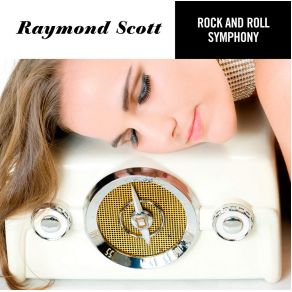The Rock'n Roll Symphony
Download links and information about The Rock'n Roll Symphony by Raymond Scott. This album was released in 1958 and it belongs to Jazz, Rock, Pop, Psychedelic genres. It contains 24 tracks with total duration of 01:15:48 minutes.

|
|
|---|---|
| Artist: | Raymond Scott |
| Release date: | 1958 |
| Genre: | Jazz, Rock, Pop, Psychedelic |
| Tracks: | 24 |
| Duration: | 01:15:48 |
| Buy it NOW at: | |
| Buy on iTunes $9.99 | |
| Buy on Amazon $8.99 | |
Tracks
[Edit]| No. | Title | Length |
|---|---|---|
| 1. | How High the Moon | 3:18 |
| 2. | Summertime | 3:31 |
| 3. | Orchids In the Moonlight | 2:28 |
| 4. | Amor | 4:10 |
| 5. | What Is This Thing Called Love | 1:59 |
| 6. | Deep Purple | 3:10 |
| 7. | Stardust | 3:31 |
| 8. | True Love | 2:42 |
| 9. | All the Things You Are | 3:48 |
| 10. | La Cumparsita | 2:26 |
| 11. | Somewhere Over the Rainbow | 3:27 |
| 12. | Where Is Your Heart | 3:30 |
| 13. | How High the Moon | 3:14 |
| 14. | Summertime | 3:30 |
| 15. | Orchids In the Moonlight | 2:27 |
| 16. | Amor | 4:09 |
| 17. | What Is This Thing Called Love | 1:58 |
| 18. | Deep Purple | 3:09 |
| 19. | Stardust | 3:31 |
| 20. | True Love | 2:42 |
| 21. | All the Things You Are | 3:47 |
| 22. | La Cumparsita | 2:26 |
| 23. | Somewhere Over the Rainbow | 3:26 |
| 24. | Where Is Your Heart | 3:29 |
Details
[Edit]Even among his supporters, The Rock 'N' Roll Symphony is the most controversial album of Raymond Scott's career. Made in 1958 in the earliest days of Everest Records, where Scott was working A&R, it is the one commercial recording he made that reflects his day job as music director of the popular Your Hit Parade television shows. Your Hit Parade was sort of the 1950s equivalent to American Idol except that the performers were not in competition and appeared from week to week; it started on radio in 1936 and gave rise to the first pop charts ever kept. At the end of the 1956-1957 television season, ABC fired the entire cast of the show, including Scott, owing to its inability to keep pace with the incursion of rock & roll music; indeed, watching crooner Snooky Lanson sing songs like "Rip It Up" must have seemed a little ridiculous. Although Scott's own stated purpose in making The Rock 'N' Roll Symphony was of creating "rock & roll for the entire family, mood music that will span generations," one can argue that he wanted to demonstrate to ABC that it could be done — adapting hits in a rock-styled treatment for conventional orchestra and performers. The Rock 'N' Roll Symphony was Scott's most successful LP, and was reissued twice during his lifetime under different titles, including the rather unfortunate choice of "Warm Rain."
The result is neither rock & roll nor symphony; it is rather plain, though elegant, mood music, professionally scored, with a rhythm section consisting of piano, electric bass and drums, and the distinctive sound of saxophonist Sam "The Man" Taylor — a real plus to some expert listeners, though it might not make a difference to others. Occasionally the strings are a little overbearing, and that has led to its low standing among some of Scott's most dedicated supporters, one of whom commented that he didn't care if it ever appeared on CD. Finally, the Acrobat firm in the U.K. has issued The Rock 'N' Roll Symphony on a disc containing both its mono and stereo versions.
The Rock 'N' Roll Symphony was one of the earliest stereo LPs on the American market, and the stereo version is the one to experience here on tracks 13-24 — the master tape of the mono version is in poor condition, being out of phase and containing numerous dropouts; one wonders why it was placed up front on the CD. One admires the enthusiasm of annotator Austin Powell, though — as many writers on Scott before him has done — he introduces some questionable facts and engages in some measure of hyperbole. One artist who did benefit from the example of The Rock 'N' Roll Symphony was Lawrence Welk — or rather his arranger, George Cates — who replaced the piano with a harpsichord and went on to score a number of hits, including "Calcutta," directly modeled on Scott's example. A good way to describe the effect of the album is that it is like soundtrack music for a period romantic mystery movie directed by David Lynch, though some might say that there is nothing to distinguish it from countless other easy listening albums of its kind, of which The Rock 'N' Roll Symphony was likely the first. One looking for the genius found in Scott's Quintette and electronic music will not find it here, and while the CD doesn't sound quite as good as the Everest LP pressing, it is far less expensive than trying to obtain an original. While The Rock 'N' Roll Symphony may not represent Raymond Scott at his most creative, its return to the active catalog is certainly welcome — perhaps next time we can have the far rarer "This Time with Strings."